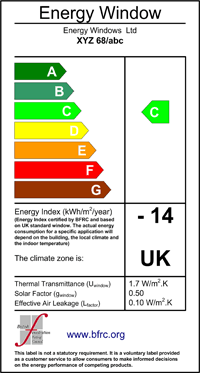Energy Saving Windows: Do they work?
In the face of the industry encouraging homeowners to replace their double-glazed windows it may not be the most cost-effective way of saving energy

You've all seen the adverts, I say, you've all seen the adverts, ‘Buy Our Energy Saving Windows'! You may have even seen claims that you can ‘Save The Planet' by buying energy saving windows, but is this true?
The British Fenestration Rating Council (BFRC) has devised a Windows Energy Rating Scheme (WERS) which is similar to the Energy Rating labels which you see on appliances like refrigerators and washing machines. The intention is to provide an easy way for the consumer to compare the thermal performance of different windows.

The label contains the following information:
1) The rating level - A, B, C, etc... 2) The energy rating e.g. -14kWh/(m2.K) in this example the product will lose 14 kilowatt hours per square metre per year. 3) The window U value e.g. 1.7W/(m2.K) 4) The effective heat loss due to air penetration as L e.g. 0.1 W/(m2.K) 5) The solar heat gain e.g. g=0.50
So, what does all that mean? To the average homeowner, not a lot, hence the rating level. A-rated must be better than B-rated etc.

In 2010 the government revised Part L of the Building Regulations which governs energy consumption in buildings. It is a complicated document, not for the faint-hearted. As a result, most people (including the government) try to simplify it, by taking headlines from it. The headline used by most double glazing salesmen is that a window must be C-Rated or better to meet Part L. This is actually not the case, but will be the subject of another article later in the year.
The double glazing industry has jumped on the WERS and the revision to Part L as a way of promoting the second-time replacement of windows. This market has faltered during the recession with the availability of credit for homeowners almost disappearing.
Exquisite houses, the beauty of Nature, and how to get the most from your life, straight to your inbox.
In the middle of the recession, having seen the success of the car and boiler scrappage schemes, the double glazing industry looked to promote a windows scrappage scheme, and created a petition at hmg.gov.uk. The government's response was: "The Government agrees that energy efficiency has an important part to play if we are to achieve our carbon reduction targets. The benefits of energy efficiency for households are clear: saving money on energy bills, reducing reliance on imported energy and helping householders reduce their carbon emissions.
"However given the high cost of replacement windows (typically £5,000 to £10,000 for a small home), the marginal improvement in performance, particularly when replacing like-for-like double glazed windows; and given that band C windows will be the minimum standard permitted by building regulations from October 2010, a window scrappage scheme is unlikely to be cost effective on energy efficiency and carbon savings grounds."
Given that the government believes that a window scrappage scheme "is unlikely to be cost effective" and that there would be only a "marginal improvement in performance," how efficient are energy efficient windows, and what is the difference in performance between the window Ratings?
On their members' website, the Glass and Glazing Federation provide an Energy Saving Calculator from which I got some interesting results.
I used it to calculate the annual energy cost savings, and reduction in carbon dioxide emissions and carbon footprint as a result of replacing single-glazed steel frames in a 4-bedroomed, detached property, with gas-fired central heating, and an average window area, with, windows of various ratings. The full results are listed below.

I have to be honest, I understand the difference between £280.71 and £321.10 which is less than 80p per week, but the CO2 and Carbon figures meant nothing to me.
So I used the carbon footprint calculator at carbonfootprint.com , and the carbon emissions comparison calculator at transportdirect.info to convert the Carbon and CO2 emissions into equivalent commuting days.
My journey to work is 15 miles each way, and I drive a 2.0 litre diesel saloon. My annual commute results in CO2 emissions of 3.11 tonnes, and my carbon footprint is extended by 2.34 tonnes. The revised results including commuting days are below.

As you can see, the difference between a D Rated window (which many salesmen would have you believe does not meet the Building Regulations - more on that in a later article) and an A Rated window is 80p per week on your energy bill, 18 days' commuting for CO2 emissions, and 7 days' commuting for your carbon footprint.
It is clear that significant benefits can come from the replacement of single glass with double glazed units, and improved weatherproofing, rather than from upgrading existing double glazed units, hence the government's response to the petition for a window scrappage scheme.
Of course, these figures are all theoretical. The actual results are dependent upon the homeowner taking advantage of the improved thermal performance. Studies in New Zealand showed that homeowners whose property had been retrofitted with improved insulation did not realise the potential energy savings, because they preferred to have a warmer home, rather than save energy by keeping it at temperatures they had become used to.
John Keleher is the IT Manager of Crittall Windows, who produce the same slim, elegant frames as the original steel windows, with the option of thermally efficient double glazed units, as well as single glass. His previous position was Manufacturing Systems Manager for the Engineering Division of VSEL (now part of BAE Systems), the company that built the Trident nuclear submarine fleet and Trafalgar Class hunter-killer submarines among other armaments.
In addition to the windows industry, he takes an active interest in conservation, heritage, construction, architecture, design and technology.
You can follow John on Twitter at @johnkatcrittall

This is an article from ProjectBook which provides a wide range of information for the conservation, restoration, care and repair of period and listed buildings. Crittall Windows is featured in ProjectBook's specialist Products Directory. Updated daily with new content, the website features the Heritage Register which contains over 500 vetted craftsmen, contractors and consultants from all over the UK, a products directory, informative articles, current news, events and more. For more information, visit www.projectbook.co.uk
Country Life is unlike any other magazine: the only glossy weekly on the newsstand and the only magazine that has been guest-edited by His Majesty The King not once, but twice. It is a celebration of modern rural life and all its diverse joys and pleasures — that was first published in Queen Victoria's Diamond Jubilee year. Our eclectic mixture of witty and informative content — from the most up-to-date property news and commentary and a coveted glimpse inside some of the UK's best houses and gardens, to gardening, the arts and interior design, written by experts in their field — still cannot be found in print or online, anywhere else.

